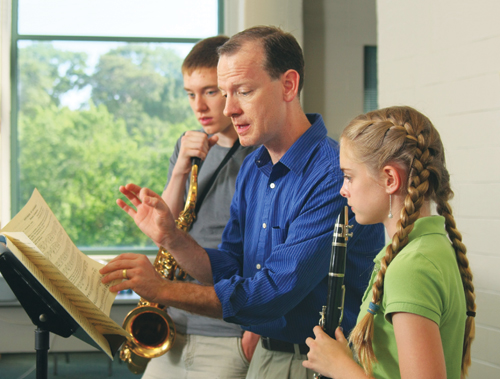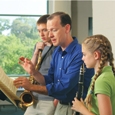
Sightreading is intimidating, daunting, and mysterious to many musicians. Too often students are told that the best way to learn to sightread better is simply to practice sightreading without any direction or method. This non-answer causes confusion and frustration. Merely sightreading more music without clear guidance is like slinging wet mud on a wall in the dark expecting to create a beautiful picture. Some of the mud will stick, but it will not be pretty.
Sightreading is a true test of independent musicianship. If you want to prepare your students to both desire and to be capable of participation in music after they leave high school and college, then you must help them become independent musicians. Good sightreading skills enable students to form chamber ensembles, play successfully in church ensembles, and participate confidently and successfully in community bands and orchestras.
The following techniques work well with small ensembles as well as with the full band and orchestra. They are simple to develop and easily incorporated into warmup and reading time. Directors can insert sightreading opportunities throughout rehearsals. Students should also use the techniques in their private practices. For the band director who wants to equip students to earn district and state band seats, or win college scholarships, sightreading is the key component that often separates the top positions in any ensemble.
The Perusal Stage
Studies have shown that the ability to organize and sort through information while sightreading is divided into two parts: the perusal phase and the physical act of reading. When the music is placed before a musician the initial step is a period of examining the music. Students are typically given little guidance on how best to use these precious minutes before the clock stops, and they begin to play. Some common problems include staring at one section of music too long; lack of proper scanning; little focus; not mentally hearing the music, or using an internal metronome. These and other distracting elements affect the concentration of the performer. Fears often creep in, mental barriers develop, and the piece becomes overwhelming to the performer. This makes an audition or first attempt at a piece even more daunting. In an audition, the time allowed to look at a piece of music usually ranges from thirty to sixty seconds. To best utilize this limited time, students should have simple, memorable steps to follow that create a systematic methodology.
Step 1: Time Signatures
Students should first rapidly scan the excerpt to discover the meter of the music, and at what (if any) point in the selection there is a meter change. The performer should take critical note of the meter. Does it change from simple to compound time? Does the excerpt have a complex meter? What is the feel and meter within the selection? This should take no more than 2-3 seconds to scan, locate, sound out, and count through.
Step 2: Key Signature
After checking the key signature, scan through the piece to locate any changes. Keys with multiple sharps or flats often include other accidentals. The performer should finger through the key on the instrument, mentally noting the names of the notes that are altered. Then he should slowly finger through the accidental passages. The initial scanning time should take no more than two to four seconds.
Step 3: Range of notes
Determine the highest and lowest notes in the excerpt. It is often a refreshing surprise to realize that the excerpt includes only one octave, even if it is difficult to perform. This should take no more than two to three seconds.
Step 4: Speed and Rhythm of difficult passages and patterns.
This stage should take the most time. Students should start by looking at any rhythmically challenging figures, syncopations, odd meter rests, and strangely written phrases. It is helpful to look for rhythmic or diatonic patterns. Phrase markings within the music frequently highlight similarities in rhythmic patterns. Where the slur starts and ends within a rhythmic passage will clue the performer that this passage may occur again.
As the rhythmic challenges are discovered, the performer should sing and finger the notes at a slow tempo several times. Vocalists should whisper the rhythms on their lips as they sound out the lyric. As the passage becomes more comfortable, performers should rapidly pick up tempo, reaching as close to performance tempo as possible.
Step 5: Style, Tempo, Articulations and Phrases.
Next look at the written style, overall tempo, and specific phrase markings within the excerpt of music. This should take 4-5 seconds. As the musicians practice these steps, it becomes easier to scan the music more fluidly.
Advanced Techniques
More complicated excerpts require additional techniques. Students in private lessons often excel in sightreading because they employ the following techniques as they prepare for placement auditions and college scholarship competitions.
Tongue The Ties
Counting rhythmic passages can be difficult when there are tied notes over a bar line or weak beat. In this instance, it is best to tongue all notes within the tie and omit the tie. The passage becomes much easier, and although it is not exactly what is written, it includes keeps the rhythm and technique properly placed within the phrase. Ties can easily be added the second time through.
When in Doubt, Leave it Out
This corollary applies to ornamentation, appoggiaturas, mordents and trills, turns, and any other phrase decoration. Simply leave these nuances out of the phrase when the excerpt is played for the first time. It is more important to perform the correct rhythm.
Front to Back
When a student encounters a challenging rhythmic passage that is hard to count, the tendency is to read from left to right, hoping to eventually find relief from the rhythmic challenge. A better approach is to look at the passage differently. If the start of the passage is hard to count and the down beats are unclear, go to the end of the measure and find where the final beat falls. From this point gradually back up, one beat at a time and sound it out by singing and fingering the notes. Essentially, the passage is approached from the end to the beginning. This technique, when employed correctly, is highly effective and efficient.
Mental Hashmarks
This advanced technique is a wonderful way to sound out difficult rhythms. Without a pencil available in an audition, a reader mentally targets difficult rhythmic passages. One of the best ways to sound out harder rhythms is to place a mental hashmark above the spot where each beat actually falls within a measure of music. It is easier to sing and finger the notes when the down beat has been identified. All divided and sub-divided rhythms become much easier to read and count.
When individual musicians become proficient in sightreading techniques, it is a component that catapults an ensemble to higher levels of literature. Although it may seem time consuming to teach the techniques to the entire ensemble, the advancement in playing ability makes it worthwhile. When the director can choose more challenging music, it enhances the experience for students and audiences. The more difficult literature offers students the preparation to further their education in music beyond the high school level.
Further Reading
Teaching Band and Orchestra: Methods and Materials by Lynn Cooper (GIA).






